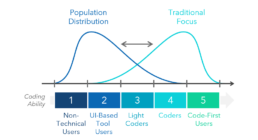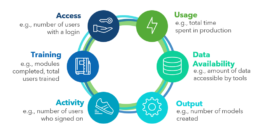The Future of Analytics
Analytics capabilities alone are no longer a differentiator in the market; leveraging data as a strategic tool has come to be the norm rather than the exception. A recent survey (1) reports that 89% of respondents identified analyzed data as essential to their organization’s innovation strategy, suggesting that the ability to harvest and utilize data is now more a corporate standard than a competitive edge. Firms still pursuing strategic innovation in analytics need to look deeper if they seek to stay ahead. Top-down implementation alone doesn’t necessitate that analytics capabilities are utilized to the maximum. In fact, only 16% of respondents reported that “rank-and-file” employees had access to analyzed data. This shortsighted concentration of data science capabilities reveals the critical need for democratization. Today, democratized analytics is a key differentiator, as well as core determinant in maintaining a thriving culture of analytics.
What exactly does democratization look like? Fundamentally, it is the widespread unification of strategy and analytics, such that no strategic decision is starved of data-fueled evidence and predictive modeling. This can be dissected into four key tenets:
1.Egalitarianism – Building an environment where data science isn’t just limited to experts
2.Inclusivity – Distributing widespread access to data without prohibitive gatekeepers or undue barriers to entry
3.Empowerment – Creating a culture where everyone feels enabled to make data-fueled strategic decisions
4.Universal Participation – Assembling teams of “DIY data scientists” to tackle ubiquitous deposits of smaller data capable of enlightening everyday choices and priorities
Even once acknowledged, establishing and adhering to these principles remains a challenge of its own; the importance of instituting a strategic approach with clear metrics by which to measure progress cannot be understated.
Exhibit 1. Democratization fills an immense white space
Why Democratize?
Within many organizations, the fruits of analytics are uniquely limited to those who can orchestrate the priorities of data science teams under their jurisdiction. Even if this approach consistently produces valuable strategic insights, it is inevitably limited by the scale of the effort. For instance, whereas many firms hire data scientists to leverage obvious amalgamations of “big data”, there are much smaller deposits of data encountered on a day-to-day basis by less technical employees which expensive data science resources could never fully come to tackle.
Ultimately, democratization aims to unify strategy and analytics all along the corporate ladder, and the keystone of this is building a do-it-yourself analytics culture. Employees embedded in the operations of the business should be able to harness data on-the-fly and generate useful insights without severely disrupting their workflow. Without this competency, workers either make gametime decisions based on hunches or try to enlist help from a data science team, which can be complicated, a poor use of limited resources, or even outright undoable within the organizational context.
Making analytics accessible to the entire organization extends the reach of data-fueled intuition outside of privileged cells with sparse awareness and a limited reach. Through a careful blend of training, tooling, and organizational realignment, employees can be upskilled to make the best use of existing resources rather than searching for experienced hires who can only be stretched so thin.
Intermingled with expanded access, democratization yields several other distinct benefits:
- Quicker implementation, including reduced queues for limited data science resources and less need for back-and-forth iteration
- More local collaboration, where models can be made and owned by teams in the field instead of delegated to enlisted data scientists
- Streamlined data science workflow, owing to fewer dependencies
- Cost avoidance, as existing employees can supplant otherwise expensive data science resources
This list is far from exhaustive, but it highlights democratization as a key priority for any organization already invested in analytics.
Exhibit 2. Spectrum of employee technical ability
Strategic Approach and Vision
Democratization ultimately entails disrupting the status quo for a substantial number of employees, and so if initiatives aren’t continuously communicated with meticulous clarity — or if management fails to display resoluteness in their commitment — then it will be very difficult to spur any progress. An outspokenly inclusive concept of data science needs to be evident in any messaging from leadership; nontechnical employees will likely assume that data science isn’t meant for them unless it is forthrightly proclaimed otherwise. Making data science seem approachable to currently inexperienced employees needs to be of utmost importance.
Additionally, two key enablers for democratization should be prioritized:
1.Curated Toolset – AutoML and self-service business intelligence tools are available in abundance on the market and offer an array of capabilities, allowing for the compilation of tailormade suite of tools depending on organizational needs. Some features to consider include being able to browse data with robust exploration capabilities (e.g., natural language search, data catalogues), to produce quick and easy visualizations, and to leverage machine learning to simplify analytics to less technical users.
2.Accessible Data – Even the best tools are only useful insofar as relevant and workable data is in reach of users. With this said, implicit in the idea of accessibility are inclusivity, availability, and comprehensibility. Coherent strategies need to be put in place in advance to ensure that data is useable by tools (i.e., de-siloed), available to as many users as possible within the bounds of privacy and security restrictions (i.e., via comprehensive access management), and well-documented such that a reasonable user could use it without significant risk of misinterpretation (i.e., using data dictionaries).
Democratization is ultimately about making data and analytics accessible to the masses, and with more people inevitably comes more complexity. With so many users, finding the right data can quickly turn into searching for a needle in a haystack, and poor access management can beget poor data security or overwhelmed gatekeepers. If either tooling or data accessibility are lacking, crowd control becomes virtually impossible. In addition, democratization has several dependencies that can slow or stall progress.
Paramount amongst these are training and IT support. Importantly, tools and data are only useful insofar as there is a commitment from IT to stand up and maintain them, and only so long as employees feel empowered to use them. With respect to training, the focus should be on both tool-specific skills and on using and interpreting the result of analytics. To foster this, a clear outline of the data science process should be promoted to demystify it to nontechnical employees. The IT team may also be pivotal in producing important usership data that can be used to gauge adoption, which is essential to tracking progress and cannot be overlooked.
Democratization needs to be treated as an ongoing process and not a one-time investment. Ensuring that current employees are impacted isn’t always enough to enact permanent change, and so further action should be taken to better fuel the process indefinitely. For instance, whereas it is secondary to upskilling existing employees in the short-term, making basic analytics skills a hiring priority for traditionally nontechnical positions can help to seal in the investment for the future.
Getting Implementation Right
1. Adapting to the User Base
Democratization is a complex process with many moving parts, and so it is easy to get lost without a good sense of direction. Assembling a product and onboarding roadmap in advance is essential. Tooling decisions, capability rollouts, trainings, and onboarding goals should all be set ahead of time. However, how are different user populations best balanced and prioritized?
It may be tempting to start by searching for the ideal toolset that fulfills every requirement, but such an endeavor takes time and requires significant feedback. With this considered, tooling choices are often best made in repeated outward steps from the most code-heavy userbase; the most valuable insight into the needs of incrementally less technical employees will first come from those on the margin who are attempting to learn. In this way, feedback takes a paramount role in tooling choices and capability build-outs, avoiding the unknowns associated with trying to match features to needs of users without any actual experience.
Continuous training is the next imperative. Learning sessions should be tailored to specific job functions such that the knowledge transfer is internalized, and the benefits are clearly communicated for every line of business. Both tool-oriented and general analytics trainings are needed, as tools are only useful insofar as employees are capable of and confident in producing actionable insights. Ultimately, this training regimen needs to be both targeted and aggressive.
Exhibit 3. Typical mismatch between skillset of user base and the target audience for code-heavy analytics tools
2. Ensuring Progress
Democratization isn’t always easy to measure; the permeation of analytics throughout an organization isn’t entirely reduceable to a couple of statistics, though there are a few important metrics that together can begin to give an indication:
- Tool Access – The number of users who have the necessary software or logins needed to use existing tools. If access management is decentralized, the breadth of analytics access is best measured by compiling a deduplicated list of users across the entire suite.
- Training – The number of employees who have received any training in analytics or the associated tools, whether that be in a classroom or a self-service setting. Together with tool access, this is an essential component of gauging onboarding.
- Activity – This metric has a much less straightforward definition depending upon the tools being used and the usage data that is available. Fundamentally, leadership should have some indication of how much tools are being used, whether that means aggregate time spent by users, number of logins in a given timespan, etc.
Devising a process flow for obtaining this data and producing reliable statistics is crucial, likely requiring collaboration with IT. To target specific segments of the employee population, these statistics can be broken out by coding ability, job function, or business unit, revealing localized needs.
Additionally, keeping tabs on democratization efforts necessitates having a comprehensive method for tracking dependencies. IT support and data access were already mentioned in the context of high-level strategic alignment, but there needs to be a means of documenting and relaying present and future needs to the data and infrastructure teams.
Exhibit 4. Examples of possible KPIs
For instance, it might be helpful to routinely map out tooling and data requirements across a number of different dimensions (e.g., coding ability, job function, business unit). This method helps to efficiently allocate tasks and illustrate progress over time, especially with respect to the more qualitative components of the democratization process. Lacking the capability to compile such a dashboard would make it difficult to assure that all gaps are filled and that every portion of the population is fully satisfied.
3. Distributing Access
When dealing with analytics tools, successful access management entails walking the fine line between distributing keys to as many employees as possible and keeping software licensing costs under control. Democratization is not nearly as simple as giving each employee a login to every tool; liberal access and waste need to be balanced. Appropriate entitlement management and controls are increasingly important as employees are upskilled throughout the organization. Gaining access should have a clear and defined process, and extra care needs to be taken to assure that it isn’t just distributed ad-hoc within organizational silos where it is frequently used.
For larger organizations where the suite of tools is relatively expansive, a single unified analytics access point may be needed. Centralizing all capabilities around a core hub maximizes accessibility — completely streamlining the process flow for accessing software — and facilitates the sought-after egalitarian experience. This may also make it easier to collect certain tracking metrics, as all traffic is directed through a single entrance as opposed to distributed gates. While this sort of central hub isn’t necessarily, especially for smaller firms, it can help decomplicate analytics via a well-crafted user interface and a simplified access procedure.
Common Pitfalls
Typical mistakes that organizations make while working to democratize their data science capabilities include:
-
Data-First Mentality
– Oftentimes, companies will make the misstep of devoting data scientists or democratization efforts to the areas with the most abundant data, not the areas with the highest potential for strategic gains. Strategy is paramount, and data is only useful insofar as it contributes to strategy. Employees should be trained to harness analytics wherever data appears, not just where it is plentiful; this is the essence of democratization.
-
Mismanagement
– Having a lot of hands touching a lot of data can very quickly result in an unmanageable mess if the proper governance isn’t place and the right tools aren’t selected. This potential misstep highlights the importance of well-crafted data policy and even possibly the need for a dedicated data management and quality team.
-
Misinterpretation
– Introducing data and analytics to a large group of inexperienced people introduces a real risk of misinterpretation of results. This is why general analytics trainings are important outside of tool-specific contexts; data science can be incredibly powerful, but that power must be taught to be handed responsibly or the risk is run of acting on misleading or misguided takeaways.
In Closing...
Democratization is an essential consideration for any company that seeks to leverage its analytics capabilities to scale and stay ahead of the competition. It is increasingly clear that a data science practice on its own is no longer adequate to keep up with the curve, and thus every organization needs to share the benefits of data science with all of its employees.
Clearly, the conventional approach wherein producing strategic insights is dedicated solely to teams of data scientists wholly misses this benefit of informing strategy all across an organization. Democratized analytics offers a broader vision; this ultimately has two key enablers, tools and data, which need to be strategized and clearly communicated to all employees. In practice, implementation requires a well thought out roadmap and a comprehensive set of KPIs to troubleshoot issues along the way. Then, a careful onboarding strategy which balances cost containment with widespread access should be executed.
Democratization isn’t always an easy road to go alone. Kepler Cannon’s proficiency in guiding enterprise-wide adoption of data and analytics practices makes us the ideal partner. The future of analytics is among the masses.
__________________________________________________________________________________________________________
- “Embracing Data Analytics for More Strategic Value”, Harvard Business Review, March 2021
































